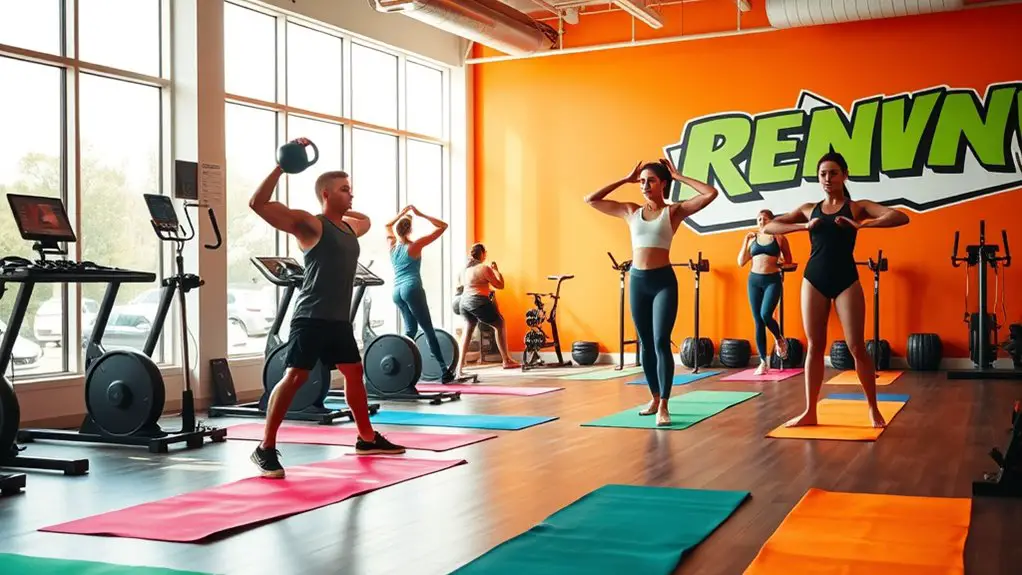How to Return to the Gym After a Long Break

Returning to the gym after a long break can be challenging, but you can make it manageable. Start by evaluating your current fitness level and setting realistic, specific goals. Create a gradual workout plan that incorporates proper form to prevent injuries. Listen to your body and don’t hesitate to rest when needed. Stay motivated by tracking your progress and celebrating small victories. If you’re looking for tips on how to enhance your journey, there’s more to explore!
Assess Your Current Fitness Level

Before you hit the gym again, it’s essential to assess your current fitness level so you can set realistic goals and avoid injury. Start with a fitness assessment, which includes evaluating your strength, endurance, flexibility, and overall mobility. You can do this by performing basic exercises like push-ups, squats, and planks, or even timed runs to gauge your cardiovascular fitness.
Consider getting a physical evaluation from a professional if you’re unsure where to begin. They can provide valuable insights into your body’s capabilities and limitations. This step not only helps you identify areas that need improvement but also boosts your confidence as you prepare to get back to working out.
Set Realistic and Achievable Goals
Now that you’ve assessed your current fitness level, it’s time to set realistic and achievable goals that align with your capabilities. Utilizing SMART goals—Specific, Measurable, Achievable, Relevant, Time-bound—can really help. Break down your larger objectives into short-term milestones to keep you motivated and on track.
Here’s a simple guide to help you outline your goals:
| Goal Type | Description | Timeline |
|---|---|---|
| Fitness Level | Increase endurance | 4 weeks |
| Weight Management | Lose 5 pounds | 6 weeks |
| Strength Training | Lift 10% more weight | 8 weeks |
| Flexibility | Improve flexibility | 2 weeks |
| Consistency | Attend gym 3 times a week | Ongoing |
Incorporating exercises like skipping rope can enhance your overall cardiovascular fitness and contribute to your weight loss goals.
Create a Gradual Workout Plan

As you prepare to get back into your workout routine, creating a gradual workout plan is essential to guarantee you don’t overwhelm yourself. Start by evaluating your current fitness level and set a realistic workout frequency that suits you. Aim for three to four sessions per week, allowing your body to adapt without risking injury.
Incorporate progressive overload into your plan—this means gradually increasing the intensity, duration, or weights of your workouts over time. For instance, if you begin with light weights or bodyweight exercises, focus on adding a bit more weight or an extra set each week.
Listen to your body and adjust your workouts accordingly. Remember, consistency in training is key, so celebrate small victories as you progress. By easing back into the gym with a structured approach, you’ll build confidence and strength without burning out.
Focus on Proper Form and Technique
While it may be tempting to jump right into heavy lifts or complex movements, focusing on proper form and technique is vital for your success and safety as you return to the gym. Prioritizing form alignment helps prevent injuries and guarantees you’re working the right muscles effectively. Start with lighter weights or bodyweight exercises to practice your movements, allowing you to master your technique without the added strain of heavy loads.
As you refine your form, pay close attention to your body mechanics. This means understanding how to position your body to maximize efficiency and effectiveness. Technique mastery isn’t just about looking good; it’s about building a strong foundation for future workouts. Additionally, practicing proper technique can help minimize injury risk, especially for high-impact exercises like jumping rope.
Incorporate Variety Into Your Routine

To keep your workouts fresh and exciting, it’s essential to incorporate variety into your routine. Not only does this help you avoid boredom, but it also brings numerous cross training benefits, like improved strength and endurance. Mixing things up will keep you motivated and engaged!
Here are some fun workout ideas to try:
| Workout Type | Duration | Frequency |
|---|---|---|
| HIIT (High Intensity Interval Training) | 20-30 minutes | 2-3 times a week |
| Yoga or Pilates | 30-60 minutes | 1-2 times a week |
| Swimming | 30-45 minutes | 1-2 times a week |
| Outdoor Activities | Varies | Weekly |
Experimenting with different classes, exercises, or outdoor activities can enhance your fitness journey. So, don’t hesitate to explore new workouts and find what you truly enjoy! Incorporating jump rope exercises into your routine can further diversify your workouts and improve overall fitness.
Listen to Your Body and Rest When Needed
Listening to your body is crucial when returning to the gym after a long break, since it can help prevent injuries and guarantee a sustainable fitness journey. Pay close attention to your body signals—like fatigue or soreness—and don’t hesitate to take breaks when needed. Implementing effective rest techniques will enhance your recovery and performance.
- Prioritize Sleep: Quality sleep is essential for muscle recovery and overall well-being.
- Incorporate Active Rest Days: Light activities like walking or yoga can keep you moving while allowing your body to heal.
- Use Stretching and Foam Rolling: These techniques can alleviate tension and improve flexibility, supporting your fitness goals. Additionally, recognizing the importance of rest days is essential to avoid burnout and maintain motivation in your fitness journey.
Stay Motivated and Track Your Progress
After ensuring you’re well-rested and attuned to your body’s needs, the next step is to keep your motivation high and track your progress. Use motivation techniques like setting small, achievable goals to maintain your focus. Celebrate each milestone, no matter how minor, as these victories will keep your spirits up.
Progress journaling is a fantastic tool to visualize your journey. Document your workouts, how you felt, and any changes you observe. This not only helps you stay accountable but also reveals patterns that can enhance your routine. Regularly reviewing your journal can remind you of your hard work and resilience, reinforcing your commitment.
Seek Support From Fitness Communities or Professionals
Getting back to the gym can feel overwhelming, but you don’t have to do it alone. Joining local fitness groups or hiring a personal trainer can provide the support and motivation you need to stay on track. Surrounding yourself with others who share your goals makes the journey not just easier, but also more enjoyable!
Join Local Fitness Groups
When you’re ready to dive back into your fitness routine, joining local fitness groups can be a game-changer. Not only do these groups provide motivation, but they also foster a sense of community that makes working out more enjoyable. With local gym partnerships and community fitness events, you’ll find the support you need to stick with your goals.
- Connect with like-minded individuals who share your fitness ambitions.
- Participate in community fitness events that keep you engaged and accountable.
- Gain access to exclusive workouts and resources through local gym partnerships.
Embracing the power of a fitness community can help you overcome any hesitations and reignite your passion for exercise. So, go ahead—find your tribe and get moving!
Hire a Personal Trainer
Hiring a personal trainer can be one of the smartest decisions you make as you return to the gym. They bring expertise, motivation, and a personalized approach to your fitness journey. With their guidance, you’ll not only learn the right techniques but also stay accountable to your goals.
Here are some personal trainer benefits to reflect on when finding trainers:
| Benefit | Description |
|---|---|
| Customized Workouts | Tailored programs that fit your fitness level. |
| Expert Guidance | Professional advice on form and technique. |
| Motivation | Encouragement to push through tough workouts. |
| Accountability | Regular check-ins to keep you on track. |
| Injury Prevention | Knowledge to avoid exercises that may cause harm. |
Investing in a trainer can make your return to the gym feel less intimidating and more exciting!
Frequently Asked Questions
How Long Does It Take to See Results After Returning to the Gym?
Think of planting a seed; it takes time to sprout. You’ll likely see initial results in 4-6 weeks, but keep realistic expectations. Progress timelines vary, so stay patient and celebrate every small victory along the way.
What Should I Wear for My First Workout Back?
For your first workout back, choose exercise attire that prioritizes comfort levels. Opt for breathable fabrics and supportive footwear; feeling good in what you wear boosts motivation and helps you focus on your workout.
Can I Still Work Out if I Feel Sore?
Yes, you can still work out if you’re sore! Focus on soreness management and consider workout modifications, like lighter exercises or stretching. It’s a great way to stay active while your body recovers!
Should I Consult a Doctor Before Starting Again?
Before starting again, it’s wise to consult a doctor. A fitness assessment can help identify any underlying issues, ensuring injury prevention. You want to train smart, not hard, so listen to your body!
What Should I Eat Before and After Workouts?
Before workouts, you should grab pre-workout snacks like bananas or protein bars for energy. After, focus on post-workout meals rich in protein and carbs, like chicken with quinoa, to refuel and aid recovery.





